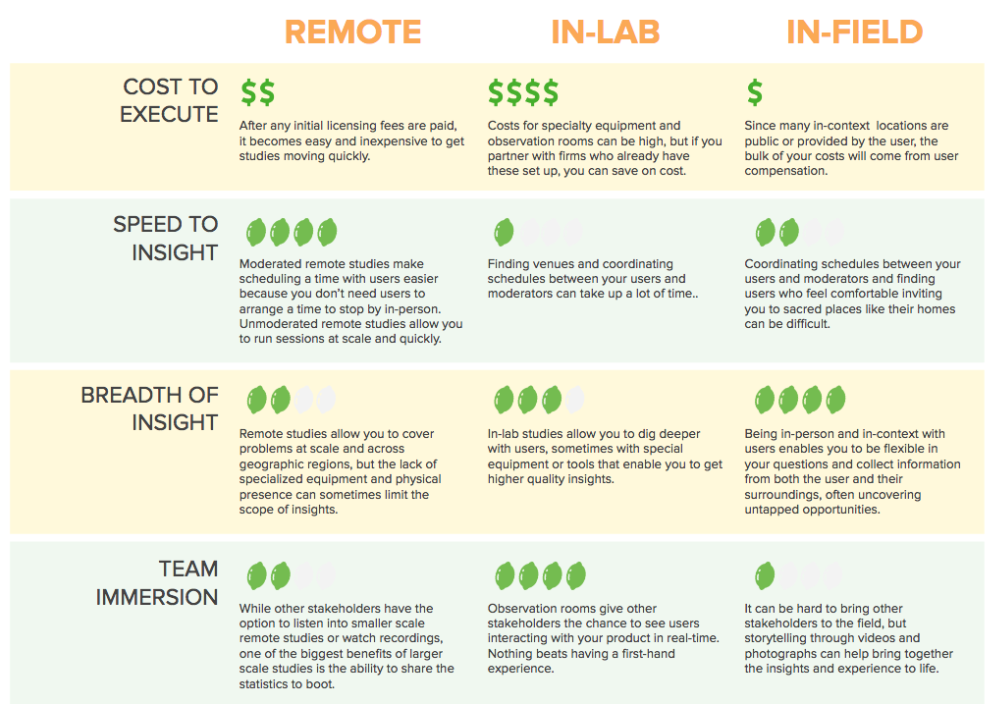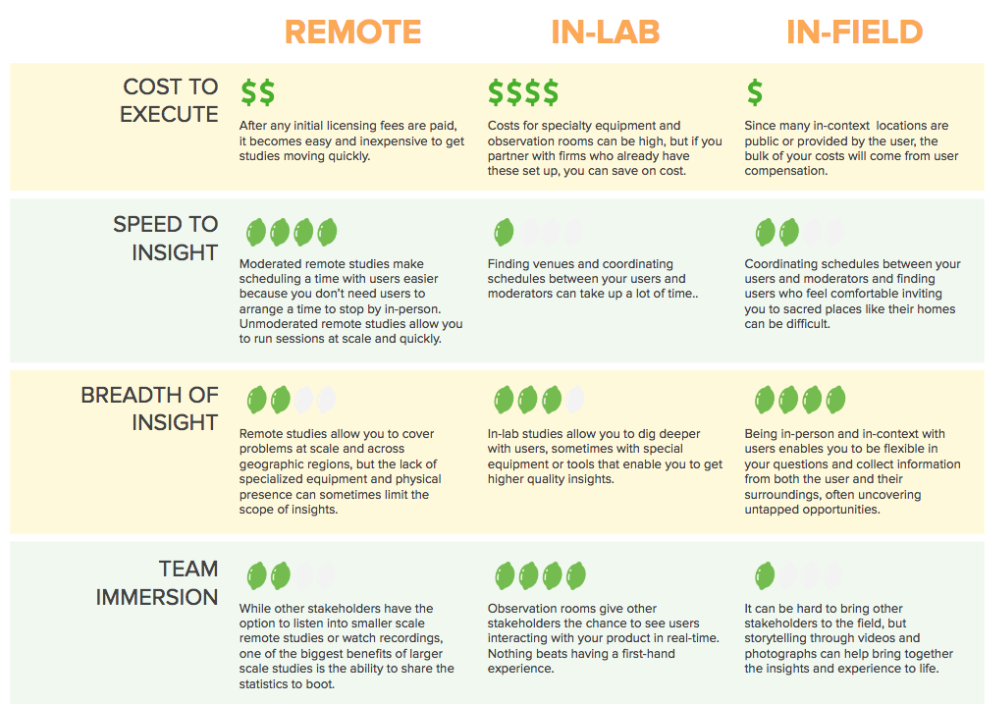
Let me ask you a question. Have you ever asked yourself, "where should I connect with my users to get the feedback I need?" After deciding how to proceed, did you get the answers you were seeking? If not, perhaps where you met the user wasn’t the ideal place.
At KLI, we help our clients identify the most ideal venue based on a number of factors: the type of questions they have, the type of data/observations they seek, the amount of time they have, and their budget.
Generally speaking, and independent of which methodology is best, there are 3 places to gather feedback from your user.
- Remotely - researcher and participants NOT in the same place
- In the lab - face to face but in a controlled environment
- In the field - face to face and in the environment where the interaction naturally takes place
To help you understand how and why certain decisions are made, I’m using a single realistic scenario with varying conditions, that I hope helps you choose the best location.
____________________________________________________________________________________
SCENARIO A: You are the PM for a mobile app. It has been available to users for some time now but conversion is not where you hoped it would be.
Conditions: You have some hypotheses as to why but you’d like to hear from your users directly. You are pretty certain that something is happening “in the moment” but that is currently a blind spot for you. You know getting this understanding will support the long term strategy of the app.
Which option is best? A) Remote B) In the lab C) In the field
--------------------------------------------------------------------------------------------
In this scenario, it appears that context is of great importance. For that reason, in the field (C), appears to be the best fit. You can walk through or observe the user as they interact with your app naturally and surrounded by all the external factors that may be influencing what is occurring. Your ability to find the “right” users is also an added benefit since you are immersing yourself where the interaction naturally takes place. To your benefit, this also tends to be a cost effective means for collecting data (assuming getting to the place users are is possible for you).
There are a few things you should be aware of though. You likely cannot get too deep with each participant as interviews will likely be on the short side, maybe only 15-20 min max. Recruiting can prove to be a bit more difficult than you think as people may be very selective with their time. Since you are in the field, the environment will be less controlled and can be noisy or distracting to your research needs.
Even though there are challenges, none of them outweigh the benefit that you gain from this location which is context. If understanding what and how the user interacts within the scenario is of great importance, then collecting insights in the field is what you should aim for.
____________________________________________________________________________________
SCENARIO B: You are the PM for a mobile app. It has been available to users for some time now but conversion is not where you hoped it would be.
Conditions: The team is preparing for a new marketing push within 3 weeks and you need to find out what isn’t working so the message hits the mark. You need insights fast but your budget is almost nonexistent.
Which option is best? A) Remote B) In the lab C) In the field
--------------------------------------------------------------------------------------------
Hmm, seems like you are strapped for time and have little money, does this sound familiar? In situations like this, remote (A) user testing is a strong option to consider. When choosing this means of outreach, logistics/planning is typically your biggest hurdle. How are you going to recruit your users, what will they need to participate, can you get them to show you how they actually use your app, are the types of questions you need to think through as you are planning.
Lucky for you, you have some things working for you. Tools to support your desire to run remote user research are plentiful. Both quantitative and qualitative research methods are options for you. Remote data collection opens up a geographically diverse user base. Remote user studies, not inclusive of software purchases, are usually cost effective.
____________________________________________________________________________________
SCENARIO C: You are the PM for a mobile app. It has been available to users for some time now but conversion is not where you hoped it would be.
Conditions: The team has varying opinions as to what the culprit is. Some think the UI needs some refining while others believe the value prop is misaligned. Your determined to get the team on the same page to figure it out because the life of the product depends on it.
Which option is best? A) Remote B) In the lab C) In the field
--------------------------------------------------------------------------------------------
Unfortunately within product teams, varying opinions as to the cause of issues is a normal occurrence. Assuming you have budget for this or a space dedicated for user testing, in the lab (B), sounds like a really good choice here. A benefit of this location is your ability to isolate some of the external factors that might be at play. This location also affords you the ability to dig a little deeper with your users. Many lab setups also provide a space for multiple team members to observe, for themselves, and hear directly from the user’s mouth what isn’t working.
Like all locations, there are things to be mindful of. This location is often most costly unless your company already has a space available to you. Planning and executing research in the lab adds a layer of logistics that can extend your timeline. For some, the lab is viewed as an “artificial” environment, however, some of this can be mitigated by a good moderator and how they connect with the participants.
Despite some of these factors, researchers have been conducting studies in labs for years. The ability to control the environment at times is a huge positive and allows the researcher the ability to really own the experience in a way that neither remote or in the field options can.
I hope you found this helpful. I tried to keep the scenario and conditions simple so you can see what factors influence the decision of location when executing user research. I could have taken you down a rabbit hole with more nuance and complexity, especially if I started to deconstruct the various methodologies available to you per location. I’ll save that for another time though.
If you have any detailed questions or unique scenarios that you’d like some guidance on, or simply want to keep the conversation going, reach out and contact us at Key Lime Interactive.
Below, I’ve provided a table you can use as quick reference when you are trying to determine which location is ideal for your user research needs:

READ MORE: Our Researchers Can Join Your Team, 5 Commonly Used Metrics In User Research, Three Superpowers that Make Up A Great Ethnographic Researcher, Strengths and Weaknesses of A True Intent Study










Comments
Add Comment